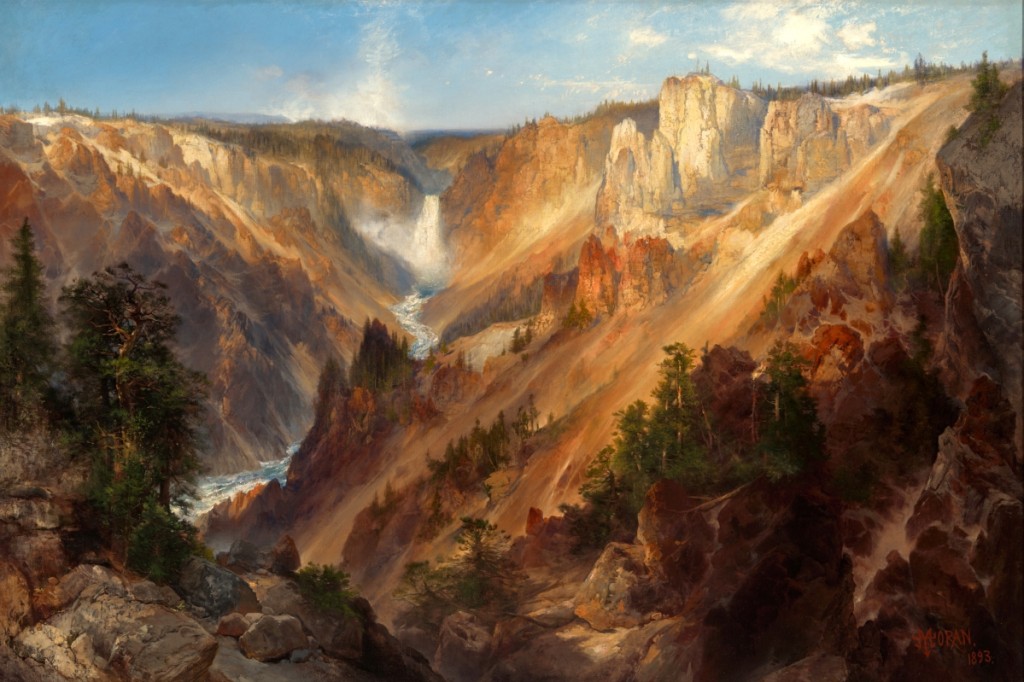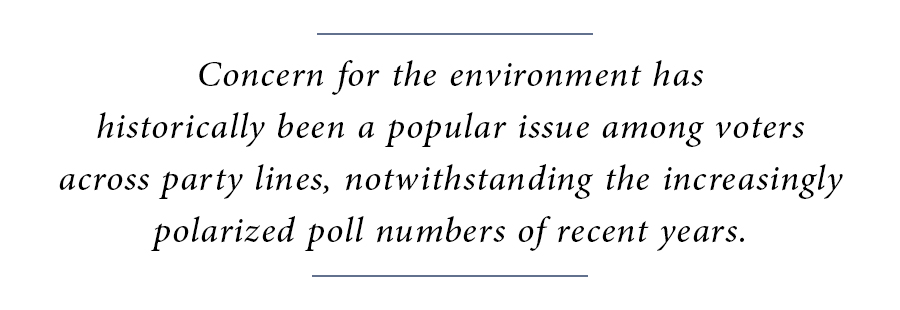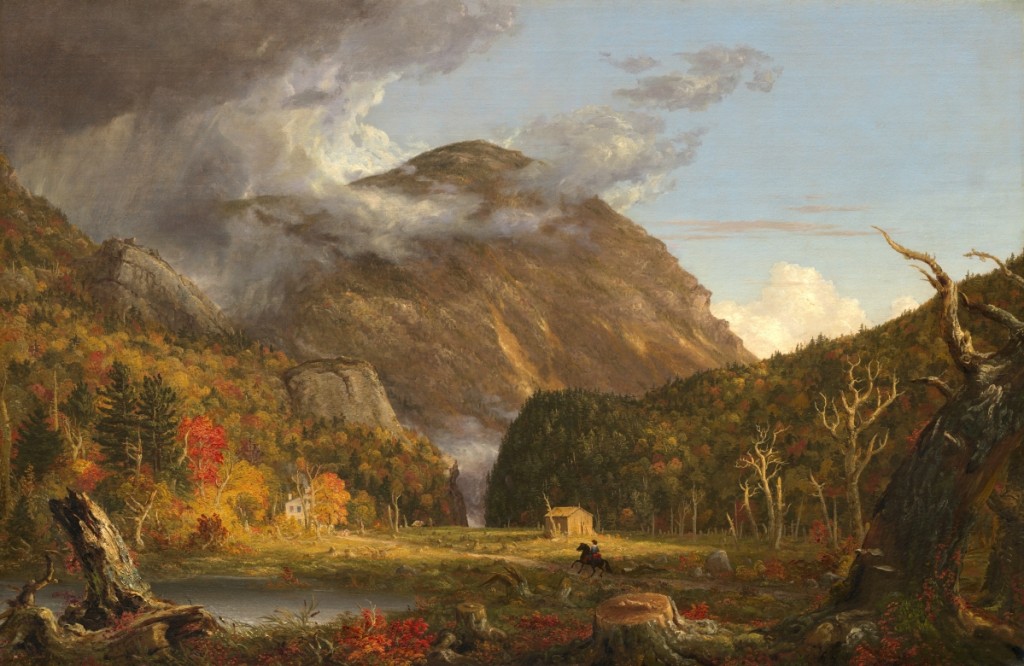
“Lower Falls, Yellowstone Park (Grand Canyon of the Yellowstone)” by Thomas Moran (American, 1837–1926), 1893. Oil on canvas. Gift of Thomas Gilcrease Foundation, 1955, Gilcrease Museum.
By Jessica Skwire Routhier
PRINCETON, N.J. – Activist art has been a familiar concept to critics, historians and consumers of art since at least the 1970s, when national and global movements related to various social issues inspired a generation of artists to use their work to promote awareness and change. A burgeoning environmental art movement, which many trace to the first Earth Day in 1970, was part of this phenomenon in the United States. As activist art has come to reside firmly in the canon of American art, the idea of an activist art exhibition is somewhat less familiar – and when it does happen, it is not always easy to identify.
Despite what may be the strong political positions of curators and the artists they choose to include, museum boards are complicated and often conservative; further, it is rarely good for attendance figures or public relations to aggressively challenge potential visitors’ views. Since the 2016 presidential election, advice from highest levels of the field has encouraged museums to refrain from taking sides on issues and, generally, to remain politically neutral.
For these reasons and surely others, activism in museum exhibitions often emerges as more of a subtext, couched in history, as in the Met’s recent outstanding Thomas Cole exhibition, which made a case for environmentalism primarily in the context of the American master’s work and travels. (It is worth pointing out here that recent exhibitions of contemporary African American art, organized by the Brooklyn Museum and the Tate, among others, have more boldly embraced activist agendas.) “Nature’s Nation,” organized by the Princeton University Art Museum and traveling to the Peabody Essex Museum and the Crystal Bridges Museum of American Art in 2019, challenges that paradigm as an exhibition with an unvarnished activist, ecological agenda. “Nature’s Nation” is on view at Princeton through January 6.
“I’ve been very concerned about climate change for 15 years,” says Karl Kusserow, who co-curated the show with William and Mary’s Alan Braddock, and with him also developed and taught a related course at Princeton for several years leading up to the exhibition. He says that a previous project (“Picturing Power,” 2013) led him “to realize that my work as an art historian could begin to bring in moral or ethical aspects of my life more generally,” and that it could be “an opportunity to bring concerns I have as a citizen to the work I do as a curator and a scholar.”
 Braddock was a natural collaborator, Kusserow points out, because he had recently edited “a very important book called Keener Perception,” one of the first to unite the emerging field of ecocriticism with American art. The Princeton museum’s press materials for “Nature’s Nation” explain that an ecocritical approach acknowledges that “works of art in all mediums and genres – not just landscape painting…have something to teach us about environmental history and perception by virtue of their subjects and contexts of creation, as well as the materials and techniques employed in their creation.” That relatively dispassionate language, however, should not suggest that the curators themselves are anything less than passionate. “I can tell you just from having talked to him about it,” says Kusserow, “that Alan’s reasons for getting interested in environmental approaches to art are also rooted in ethical concerns.”
Braddock was a natural collaborator, Kusserow points out, because he had recently edited “a very important book called Keener Perception,” one of the first to unite the emerging field of ecocriticism with American art. The Princeton museum’s press materials for “Nature’s Nation” explain that an ecocritical approach acknowledges that “works of art in all mediums and genres – not just landscape painting…have something to teach us about environmental history and perception by virtue of their subjects and contexts of creation, as well as the materials and techniques employed in their creation.” That relatively dispassionate language, however, should not suggest that the curators themselves are anything less than passionate. “I can tell you just from having talked to him about it,” says Kusserow, “that Alan’s reasons for getting interested in environmental approaches to art are also rooted in ethical concerns.”
Still, it is important to acknowledge that this activist exhibition is not necessarily an exhibition of activist art. It is true that the works on view include Twentieth Century artists whose work often intentionally engaged with social and environmental issues, as well as artwork from our present moment, in which academia has begun to recognize ecocriticism as a discrete but interdisciplinary field. But the show also encompasses a range of work from the relatively limited visual culture of the American Seventeenth and Eighteenth Centuries, when the dominant view of the newly discovered continent was an untamed wilderness waiting to be civilized, as well as the Nineteenth Century, when philosophies of extraction and industrialization dominated public thought.
Many of the earlier artists Kusserow and Braddock have included here might well raise an eyebrow at knowing that their art is being presented in service of the kind of environmental activism that Kusserow describes. Charles Willson Peale, with his authorial self-portrait in his own museum, was interested in exploring what he perceived to be a natural hierarchy in nature and the cosmos, with human beings at the apex. Thomas Moran’s spectacular “Grand Canyon of the Yellowstone” shows a Native American figure more or less handing over the keys to a leather-clad frontiersman. Even George Bellows, whose realist canvases like “Cliff Dwellers” began to reveal the problems of a society based on false ideas of superiority, was primarily interested in issues of economic, rather than environmental, justice.
What are the implications of integrating such artists’ work into such a show and a publication (the 450-page catalog distributed by Yale University Press is also designed to be a course textbook), one with a very specific point of view and an avowedly activist theme? This question dovetails with recent discussions in the field about how much control contemporary artists should have over scholarly analyses of their work with which they may disagree. “Nature’s Nation” avoids this kind of outright controversy, in part, by pushing the envelope primarily only with historical artists (most contemporary artists in the show, as a rule, have consciously engaged with a general activist agenda, if not always specifically environmentalism). For artists like Thomas Cole, represented here by the iconic “Crawford Notch,” a connection to ecological activism slides neatly into his stewards’ eagerness to identify him as a proto-environmentalist, even if that mantle sometimes hangs a little crookedly.
But it is also because environmentalism is its central activist concern – rather than thornier issues of race or gender equality or LGBTQ+ rights – that “Nature’s Nation” remains, on the whole, within the comfort zone of a wide audience. Concern for the environment has historically been a popular issue among voters across party lines, notwithstanding the increasingly polarized poll numbers of recent years. My intention in pointing this out is not to suggest that the exhibition organizers have somehow taken the easy road in presenting this exhibition and publication. I would argue the opposite, in fact – that with “Nature’s Nation” they have developed a new model for a large-scale, activist survey exhibition that might usefully be used as a template by other institutions and for other causes. Choosing a cause (environmentalism) and a venue (a university art museum) in which it is possible to do that in today’s political climate does not detract from those efforts; it makes them possible. Kusserow, Braddock, Princeton and Yale University Press – as well as the other venues for the exhibition – deserve full marks for stepping up.

“A View of the Mountain Pass Called the Notch of the White Mountains (Crawford Notch)” by Thomas Cole (American, 1801–1848), 1839. Oil on canvas. National Gallery of Art, Washington, Andrew W. Mellon Fund.
And yet because the show is not, cannot be, just for academics and activists, the challenge has been how to make it accessible to the general audience that will see it at Princeton, PEM and Crystal Bridges. The solutions are not obvious, and not yet crowd-tested, for a show that is about a theoretical approach, rather than about a specific group of objects. “It’s an issue that we really have taken sort of seriously,” Kusserow says, and a big part of the chosen strategy is a discrete, thoughtful introductory section, “literally a separate gallery with about 15 works of art.” Here visitors will encounter and can begin to wrap their minds around the main themes of the show: how ecocriticism can be applied to a wide array of works, even those that may not seem to have any particular ecological content; how human beings do not stand apart from or in opposition with nature but are part of it; and how everything is connected, ecologically speaking, on a global level.
The introductory gallery echoes the narrative of the first chapter of the book. Included in both are a Chilkat blanket from the Tlingit nation of the Pacific Northwest; Moran’s famous view of “Yellowstone Falls,” displayed alongside an intriguingly different take on the same subject by African American artist Grafton Tyler Brown; an Eighteenth Century mahogany chest-on-chest from Philadelphia; an aerial photograph by Subhankar Banerjee of migrating caribou in the Arctic Circle; and a painted map of the United States by contemporary Salish-Kootenai artist Jaune Quick-to-See Smith called “The Browning of America” – a title and a work of art that confoundingly resist any single, straightforward meaning. It is beyond the scope of this brief article to explain the ways in which an ecocritical lens can expand our understanding of such works; suffice it to say that looking at how they interact with the environment introduces and knits together unexpected issues of aesthetics, rarity, commerce and diaspora, among other themes.
The subsequent thematic sections of the show similarly encompass a broad range of artwork. Albert Bierstadt’s “Yosemite Falls” is a centerpiece of the section titled, simply, “Nature,” where it is seen in conversation with Valerie Hegarty’s “Fallen Bierstadt,” in which a painted reproduction of the earlier artist’s work seems to melt or burn as it slips from its frame. Kusserow also notes a “wonderful section of works showing human impact in the Nineteenth Century,” which includes Winslow Homer’s “Huntsman and Dogs,” Sanford Gifford’s “Hunter Mountain” and Thomas Anshutz’s Ashcan School masterpiece, “The Ironworkers’ Noontime.” A section dedicated to the American buffalo includes everything from oil paintings (George Catlin, “Dying Buffalo”) to a Sioux buffalo robe to a photograph of men standing on a shockingly tall mountain of buffalo skulls, the detritus of a federal campaign to eliminate this resource upon which Native Americans depended. The buffalo section offers a fitting epilogue to conversations about extinction begun with Peale, whose discovery and showman-like promotion of a mastodon skeleton was most scientists’ first introduction to the idea of extinction.
The organizers of “Nature’s Nation” have made serious efforts to open up the canon of American art history: beyond making a conscious effort to include women and minority artists, they have also intentionally incorporated tribal arts, furniture and printed materials into a show that in other hands might be primarily one of oil paintings. That said, the show is stocked with crowd-pleasers – hand-tinted Audubon engravings, Georgia O’Keeffe’s unforgettable “The Lawrence Tree,” a Jackson Pollock drip painting encrusted with pebbles, poetic photographs by Eliot Porter – though their presentation here is something entirely new. Even those who are deeply familiar with such iconic works will find that there is much in them that is left to consider. Those who are unfamiliar may well find that confronting such works in the context of the environment to which we all belong is as good an introduction as any to the new and expanded canon of American art.
The Princeton University Art Museum is located on the Princeton University campus in Princeton, New Jersey. For more information, 609-258-3788 or www.artmuseum.princeton.edu.


















